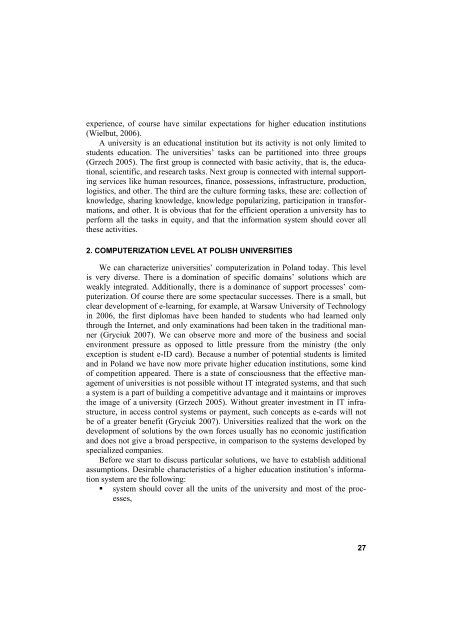INFORMATION SYSTEMS IN MANAGEMENT V - SGGW
INFORMATION SYSTEMS IN MANAGEMENT V - SGGW
INFORMATION SYSTEMS IN MANAGEMENT V - SGGW
Create successful ePaper yourself
Turn your PDF publications into a flip-book with our unique Google optimized e-Paper software.
experience, of course have similar expectations for higher education institutions<br />
(Wielbut, 2006).<br />
A university is an educational institution but its activity is not only limited to<br />
students education. The universities’ tasks can be partitioned into three groups<br />
(Grzech 2005). The first group is connected with basic activity, that is, the educational,<br />
scientific, and research tasks. Next group is connected with internal supporting<br />
services like human resources, finance, possessions, infrastructure, production,<br />
logistics, and other. The third are the culture forming tasks, these are: collection of<br />
knowledge, sharing knowledge, knowledge popularizing, participation in transformations,<br />
and other. It is obvious that for the efficient operation a university has to<br />
perform all the tasks in equity, and that the information system should cover all<br />
these activities.<br />
2. COMPUTERIZATION LEVEL AT POLISH UNIVERSITIES<br />
We can characterize universities’ computerization in Poland today. This level<br />
is very diverse. There is a domination of specific domains’ solutions which are<br />
weakly integrated. Additionally, there is a dominance of support processes’ computerization.<br />
Of course there are some spectacular successes. There is a small, but<br />
clear development of e-learning, for example, at Warsaw University of Technology<br />
in 2006, the first diplomas have been handed to students who had learned only<br />
through the Internet, and only examinations had been taken in the traditional manner<br />
(Gryciuk 2007). We can observe more and more of the business and social<br />
environment pressure as opposed to little pressure from the ministry (the only<br />
exception is student e-ID card). Because a number of potential students is limited<br />
and in Poland we have now more private higher education institutions, some kind<br />
of competition appeared. There is a state of consciousness that the effective management<br />
of universities is not possible without IT integrated systems, and that such<br />
a system is a part of building a competitive advantage and it maintains or improves<br />
the image of a university (Grzech 2005). Without greater investment in IT infrastructure,<br />
in access control systems or payment, such concepts as e-cards will not<br />
be of a greater benefit (Gryciuk 2007). Universities realized that the work on the<br />
development of solutions by the own forces usually has no economic justification<br />
and does not give a broad perspective, in comparison to the systems developed by<br />
specialized companies.<br />
Before we start to discuss particular solutions, we have to establish additional<br />
assumptions. Desirable characteristics of a higher education institution’s information<br />
system are the following:<br />
� system should cover all the units of the university and most of the processes,<br />
27


